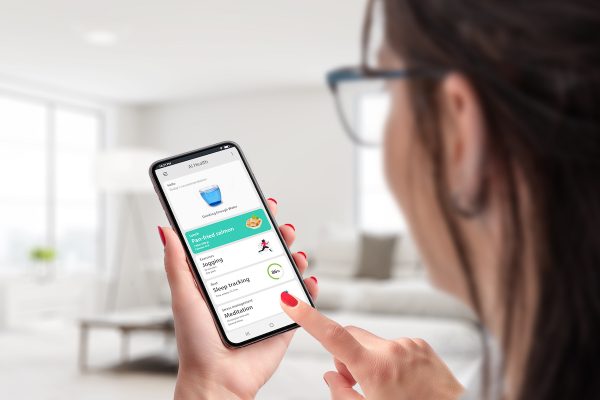

Featured
What Is Health IT
Modified: January 2, 2024
Learn about the importance of featured Health IT solutions and how they can transform healthcare delivery. Stay updated with the latest trends in technology and innovation.
Introduction
Health Information Technology (Health IT) has revolutionized the healthcare industry, playing a pivotal role in improving patient care, enhancing efficiency, and promoting better health outcomes. In today’s digital age, the use of technology has become essential in every aspect of our lives, and healthcare is no exception.
Health IT refers to the use of technology, such as electronic health records (EHRs), telemedicine, health information exchange (HIE), and clinical decision support systems (CDSS), to store, manage, and exchange health information. It enables healthcare providers to access and share patient data securely, making care coordination more seamless and reducing errors.
The importance of Health IT cannot be overstated. It has transformed healthcare delivery by streamlining administrative processes, improving clinical workflows, and facilitating informed decision-making. By harnessing the power of technology, healthcare professionals can provide more personalized and efficient care to their patients.
The key components of Health IT include the hardware, software, and networks that enable the collection, storage, and exchange of health data. These systems are designed to be user-friendly, ensuring that healthcare providers can easily navigate and input relevant patient information.
There are various types of Health IT systems, each serving a specific purpose. Electronic health record (EHR) systems allow healthcare providers to digitally create, manage, and access patient records. Telemedicine platforms enable remote consultations, allowing patients to receive timely and convenient care from the comfort of their homes. Health information exchange (HIE) platforms facilitate the seamless sharing of patient data between different healthcare organizations, ensuring continuity of care.
The benefits of Health IT are numerous. Firstly, it improves patient safety and quality of care by reducing medication errors and facilitating accurate diagnosis through access to comprehensive patient information. Secondly, it enhances care coordination, enabling healthcare professionals to collaborate effectively and ensure that all providers are well-informed about the patient’s medical history. Thirdly, it enhances efficiency by automating administrative tasks, reducing paperwork, and improving workflow processes. Finally, Health IT supports evidence-based decision-making through access to real-time data and clinical decision support systems.
However, there are challenges to adopting Health IT. Some healthcare organizations face barriers related to the initial investment, interoperability issues between systems, and resistance to change among healthcare professionals. Privacy and security concerns regarding the protection of patient data also need to be addressed to ensure compliance with regulatory requirements.
The role of Health IT in improving patient care is undeniable. It empowers patients to actively engage in their own healthcare through online portals that allow them to access their medical records, schedule appointments, and communicate with their providers. Health IT also facilitates remote monitoring for patients with chronic conditions, enabling early intervention and preventive care. Additionally, advanced analytics and data-driven insights derived from Health IT systems can contribute to population health management and research.
Overall, Health IT continues to evolve and shape the future of healthcare. The potential for innovation and the integration of emerging technologies, such as artificial intelligence and wearable devices, will further optimize patient care and outcomes. As technology continues to advance, the healthcare industry must embrace Health IT to unlock new possibilities and deliver high-quality, patient-centered care.
Definition of Health IT
Health Information Technology (Health IT) refers to the management and exchange of health information through the use of technology systems. It encompasses the hardware, software, and telecommunication networks that enable the secure storage, retrieval, and sharing of electronic health records (EHRs) and other health-related data.
Health IT plays a crucial role in the digitization and automation of healthcare processes, transforming the way healthcare providers deliver care and patients participate in their own health management. It involves the use of electronic systems to capture, manage, and exchange health information in a standardized and interoperable manner.
At its core, Health IT aims to improve the quality of care, enhance patient safety, and increase efficiency in healthcare delivery. It allows healthcare providers to have instant access to patient records, medical history, and diagnostic information, empowering them to make informed decisions and provide timely and personalized care.
One of the central components of Health IT is the electronic health record (EHR), which replaces traditional paper-based medical records with extensive digital documents that contain comprehensive patient information. EHRs can include medical history, allergies, prescriptions, lab results, and imaging reports, among other relevant data.
Health IT also encompasses other technologies and systems, such as telemedicine and telehealth, which enable remote consultations and virtual healthcare services. These platforms facilitate real-time communication between healthcare providers and patients, making healthcare more accessible and convenient, especially for those in remote or underserved areas.
Furthermore, Health IT involves health information exchange (HIE) systems that promote the seamless and secure sharing of patient data between healthcare organizations. HIE enables care coordination among different providers and ensures the continuity of care, even when patients seek treatment from multiple healthcare facilities.
As technology continues to advance, Health IT continues to evolve, with the incorporation of emerging technologies like artificial intelligence (AI) and machine learning. These technologies enable the automation of tasks, the analysis of big data to derive insights, and the development of predictive models to improve diagnosis and treatment outcomes.
In summary, Health IT is the integration of technology systems in healthcare to facilitate the management and exchange of health information. It encompasses a wide range of tools and platforms, including EHRs, telemedicine, and HIE systems. The ultimate goal is to improve patient care, enhance efficiency, and enable informed decision-making by healthcare providers.
Importance of Health IT
Health Information Technology (Health IT) holds immense importance in the healthcare industry, revolutionizing the way patient data is collected, managed, and shared. It plays a vital role in enhancing patient care, improving healthcare delivery, and driving positive health outcomes. The importance of Health IT can be understood through various key aspects:
1. Improved Patient Care and Safety:
Health IT enables healthcare providers to have instant access to accurate and comprehensive patient information. This access to real-time data facilitates more informed decision-making, leading to improved diagnoses, better treatment plans, and reduced medical errors. It also enhances patient safety by reducing the risk of medication errors and adverse drug interactions.
2. Enhanced Care Coordination:
Health IT systems support efficient and seamless care coordination among healthcare providers. Electronic Health Records (EHRs) allow different care teams to access and share patient information, ensuring that all providers have the necessary information to collaborate effectively. This coordination improves the continuity of care, especially when patients receive treatment from multiple healthcare facilities.
3. Increased Efficiency and Productivity:
Health IT automates administrative tasks, streamlining workflows and reducing paperwork. This optimization allows healthcare providers to spend more time with patients and less time on administrative burdens. Electronic systems also enable the rapid retrieval of patient data, eliminating the need for manual searching through paper records. This improved efficiency leads to a better patient experience and higher productivity for healthcare professionals.
4. Facilitates Informed Decision-Making:
Health IT systems provide healthcare providers with access to evidence-based guidelines, clinical decision support systems, and up-to-date medical research. This access to healthcare knowledge enhances the quality of clinical decision-making by guiding providers towards the most appropriate treatment plans and interventions.
5. Supports Medical Research and Public Health:
Health IT enables the aggregation and analysis of large volumes of healthcare data, allowing researchers and public health agencies to identify trends, track diseases, and conduct population health studies. This data-driven approach contributes to the improvement of public health efforts and the development of new medical breakthroughs.
6. Patient Empowerment:
Health IT empowers patients by providing them with access to their own health records, allowing them to be active participants in their healthcare decisions. Online portals and mobile applications enable patients to schedule appointments, communicate with healthcare providers, and access personalized health information, promoting patient engagement and self-management.
Overall, Health IT is essential to modern healthcare, advancing patient care, improving efficiency, and driving positive health outcomes. Its importance lies in its ability to enhance patient safety, streamline care coordination, increase efficiency, support informed decision-making, foster medical research, and empower patients to take control of their health. Embracing Health IT is crucial for healthcare organizations to thrive in the digital age and deliver the highest standard of care to their patients.
Key Components of Health IT
Health Information Technology (Health IT) encompasses various components that work together to facilitate the collection, storage, management, and exchange of patient health information. These components are crucial for ensuring the efficient and secure utilization of technology in healthcare. The key components of Health IT are as follows:
1. Electronic Health Records (EHRs):
EHRs are digital versions of patients’ paper-based medical records. They contain comprehensive information about a patient’s medical history, diagnoses, treatments, medications, lab results, and more. EHRs allow healthcare providers to access and update patient records electronically, facilitating seamless coordination and continuity of care.
2. Health Information Exchange (HIE) Systems:
HIE systems enable the secure sharing of patient information between different healthcare organizations. These systems ensure that relevant health data, such as medical records, test results, and imaging reports, can be exchanged quickly and accurately, regardless of the location or electronic health record system used by each provider.
3. Clinical Decision Support Systems (CDSS):
CDSS provides healthcare professionals with evidence-based guidelines, alerts, reminders, and other tools to support clinical decision-making. These systems help healthcare providers make informed decisions, avoid errors, and improve patient safety by providing real-time data and suggestions for the most appropriate diagnoses, treatments, and interventions.
4. Telemedicine and Telehealth Solutions:
Telemedicine and telehealth technologies enable remote patient consultations and virtual healthcare services. Through secure audio and video communication, patients can receive medical advice, consultations, and follow-up care without physically visiting a healthcare facility. These solutions improve access to care, particularly for patients in remote or underserved areas.
5. Health Information Management Systems (HIMS):
HIMS encompasses tools and software designed to securely store, organize, manage, and retrieve electronic health information. These systems support the efficient management of patient data, including data entry, retrieval, tracking, and analysis of health records.
6. Patient Portals:
Patient portals are online platforms that allow patients to access their own health information, communicate with healthcare providers, schedule appointments, refill prescriptions, and view test results. Patient portals empower individuals to actively engage in their healthcare decisions, improving patient satisfaction and contributing to better health outcomes.
7. Mobile Health (mHealth) Applications:
mHealth applications enable patients to monitor and manage their health using mobile devices. These applications range from fitness trackers to medication reminders, allowing individuals to track their vital signs, receive personalized health recommendations, and access educational resources on their smartphones or wearable devices.
These key components of Health IT work in synergy to improve patient care, enhance efficiency, and promote better health outcomes. By leveraging these technologies, healthcare providers can access and exchange health information securely, make informed clinical decisions, enhance care coordination, and engage patients in their own healthcare journey. The effective utilization of these components is vital to realizing the full potential of Health IT in modern healthcare settings.
Types of Health IT Systems
Health Information Technology (Health IT) encompasses a diverse range of systems and technologies that serve different purposes in the healthcare industry. These systems play a crucial role in managing and utilizing electronic health information. Here are some of the key types of Health IT systems:
1. Electronic Health Records (EHRs):
EHRs are comprehensive digital versions of patients’ medical records. These systems provide a centralized repository for storing patient information, including medical history, diagnoses, treatments, medications, lab results, and imaging reports. EHRs enable healthcare organizations to easily access and update patient records, ensuring the availability of accurate and up-to-date information for delivering quality care.
2. Picture Archiving and Communication Systems (PACS):
PACS is a system used to manage and store medical imaging data, such as X-rays, MRI scans, and CT scans. It enables healthcare providers to view, store, and share medical images digitally, eliminating the need for physical films. PACS allows radiologists and other medical professionals to efficiently access and interpret imaging studies, improving the speed and accuracy of diagnosis.
3. Telemedicine and Telehealth Systems:
Telemedicine and telehealth systems facilitate remote patient consultations and virtual healthcare services through secure audio and video communication channels. These systems enable healthcare providers to diagnose and treat patients remotely, reducing geographical barriers and improving access to care. Telemedicine enables timely consultations, follow-up visits, and remote monitoring, delivering healthcare to individuals in rural or underserved areas.
4. Health Information Exchange (HIE) Platforms:
HIE platforms enable the secure sharing of patient data between healthcare organizations, ensuring the seamless exchange of health information. These systems allow healthcare providers to access relevant patient information, such as medical records, medication history, and allergy information, even if the patient has received treatment from different healthcare facilities. HIE platforms improve care coordination and facilitate better communication between healthcare providers.
5. Clinical Decision Support Systems (CDSS):
CDSS utilizes algorithms, guidelines, and medical databases to provide healthcare professionals with real-time clinical decision support. These systems offer alerts, reminders, and suggestions for diagnoses, treatments, and interventions, based on evidence-based guidelines. CDSS enhances clinical decision-making by providing healthcare providers with timely and accurate information, reducing medical errors and improving patient safety.
6. Personal Health Record (PHR) Systems:
PHR systems allow individual patients to manage and access their own health information. These systems enable patients to store and track their medical history, medications, allergies, and immunization records. PHR systems empower individuals to take an active role in their healthcare, allowing them to share their health information with healthcare providers and manage their health effectively.
7. Health Analytics and Reporting Systems:
Health analytics and reporting systems utilize advanced data analysis techniques to transform raw health data into meaningful insights. These systems can identify trends, patterns, and outliers in healthcare data, helping healthcare organizations monitor population health, evaluate patient outcomes, and identify areas for improvement. Health analytics and reporting systems contribute to evidence-based decision-making and support quality improvement initiatives.
By leveraging these various types of Health IT systems, healthcare organizations can improve patient care, enhance care coordination, streamline workflows, and drive better health outcomes. Each system serves a specific purpose, but when integrated effectively, they can create a seamless and efficient healthcare environment, ultimately benefiting patients and healthcare professionals alike.
Benefits of Health IT
Health Information Technology (Health IT) offers numerous benefits that contribute to improving patient care, enhancing healthcare delivery, and driving positive health outcomes. The adoption and utilization of Health IT systems have transformed the healthcare landscape in many ways. Here are some of the key benefits of Health IT:
1. Improved Patient Safety and Quality of Care:
Health IT systems, such as Electronic Health Records (EHRs), support accurate and complete documentation of patient information. This availability of comprehensive patient data reduces medication errors, improves diagnoses, and facilitates evidence-based decision-making. Health IT also enables healthcare providers to access vital patient information in real-time, enabling them to deliver more personalized and timely care.
2. Enhanced Care Coordination:
Health IT systems enable seamless sharing of patient information among healthcare providers, facilitating effective care coordination and collaboration. Electronic Health Records (EHRs) and health information exchange (HIE) platforms ensure that all providers have access to relevant patient data, regardless of their location or organization. This interoperability ensures continuity of care and eliminates the need for redundant tests and procedures.
3. Increased Efficiency and Productivity:
Health IT systems automate administrative tasks, streamline workflows, and reduce paperwork, leading to increased efficiency in healthcare delivery. Electronic systems offer functionalities such as appointment scheduling, electronic prescribing, and automated billing, allowing healthcare providers to spend more time with patients and focus on delivering quality care.
4. Facilitates Informed Decision-Making:
Health IT systems provide healthcare professionals with access to evidence-based guidelines, best practices, and clinical decision support systems (CDSS). These tools assist in making informed decisions and provide alerts and reminders for drug interactions, allergies, and potential risks. This technology empowers healthcare providers to deliver accurate diagnoses, choose appropriate treatment plans, and improve patient outcomes.
5. Supports Population Health Management:
Health IT systems contribute to population health management by aggregating and analyzing large sets of healthcare data. These systems can identify patterns and trends, monitor population health metrics, and support public health interventions. Health IT assists healthcare organizations and public health agencies in identifying high-risk populations, implementing preventive measures, and managing chronic diseases more effectively.
6. Patient Empowerment and Engagement:
Health IT systems empower patients to take an active role in managing their health. Online patient portals, mobile applications, and personal health records (PHRs) enable individuals to access their health information, schedule appointments, view test results, and communicate with healthcare providers. This increased engagement and access to health information foster a partnership between patients and healthcare providers, leading to better health outcomes.
In summary, Health IT offers a range of benefits that improve patient care, enhance care coordination, increase efficiency, support informed decision-making, and empower patients. By embracing Health IT systems, healthcare organizations can optimize workflow processes, deliver high-quality care, and contribute to the overall improvement of healthcare outcomes. The effective adoption and utilization of Health IT continue to shape the future of healthcare and pave the way for a more patient-centered and efficient healthcare system.
Challenges in Adopting Health IT
While Health Information Technology (Health IT) offers numerous benefits, its adoption and implementation in healthcare settings are not without challenges. Organizations encounter various obstacles when incorporating Health IT systems into their operations. Understanding and addressing these challenges is crucial for successful integration. Here are some of the key challenges in adopting Health IT:
1. Initial Investment and Costs:
Implementing Health IT systems often requires a significant initial investment in terms of hardware, software, training, and infrastructure upgrades. Smaller healthcare organizations may face financial barriers, limiting their ability to adopt these technologies. The ongoing operational costs, such as maintenance, upgrades, and staff training, should also be considered, impacting the long-term sustainability of Health IT implementations.
2. Interoperability and Data Exchange:
Interoperability and seamless data exchange between different Health IT systems remain a challenge. Lack of standardization and varying technical specifications hinder effective sharing and communication of patient information. Healthcare organizations need to invest in solutions that promote interoperability, such as Health Information Exchange (HIE) platforms, to ensure the seamless flow of data between different healthcare providers and systems.
3. Resistance to Change:
The adoption of Health IT often requires healthcare professionals to change their traditional practices and workflows. Resistance to change and reluctance to embrace new technologies can impede successful implementation. Adequate training and education should be provided to healthcare staff to help them understand the benefits and overcome any apprehensions related to using Health IT systems.
4. Privacy and Security Concerns:
Healthcare organizations must comply with privacy regulations, such as the Health Insurance Portability and Accountability Act (HIPAA), to protect patient information. Implementing Health IT systems raises concerns about data breaches and unauthorized access to sensitive health information. Robust security measures, including secure networks, encryption, and access controls, are crucial to maintaining patient privacy and ensuring data security.
5. Workflow Disruptions:
The integration of Health IT systems often requires changes in workflow processes and practices, which can disrupt the established routines of healthcare providers. Learning new systems, adapting to new documentation methods, and navigating through electronic interfaces may initially result in a decrease in productivity. Proper change management strategies and training programs can assist in minimizing workflow disruptions and ensuring a smooth transition.
6. Health IT Usability:
The usability and user-friendliness of Health IT systems are key considerations for successful adoption. Complex and unintuitive interfaces can lead to user frustration and resistance. The design of Health IT systems should prioritize simplicity, efficiency, and ease of use, ensuring that healthcare professionals can easily navigate and utilize these systems in their day-to-day tasks.
Overcoming these challenges requires a coordinated effort from healthcare organizations, providers, and technology vendors. Addressing financial barriers, promoting interoperability, providing comprehensive training and support, ensuring data security, and prioritizing usability are all crucial steps in successfully adopting Health IT. Despite the challenges, the benefits of Health IT outweigh the obstacles, making it imperative for healthcare organizations to embrace these technologies to optimize care delivery and improve patient outcomes.
Role of Health IT in Improving Patient Care
Health Information Technology (Health IT) plays a pivotal role in improving patient care by facilitating access to comprehensive and accurate health information, promoting care coordination, and enhancing communication between healthcare providers and patients. The integration of Health IT systems has revolutionized healthcare delivery, providing numerous benefits that directly impact patient outcomes. Here are some key aspects of how Health IT improves patient care:
1. Comprehensive Patient Information:
Health IT systems, such as Electronic Health Records (EHRs), provide healthcare providers with instant access to comprehensive patient information, including medical history, allergies, medications, and lab results. This availability of real-time data enables healthcare professionals to make informed decisions, accurately diagnose conditions, and develop individualized treatment plans tailored to each patient’s specific needs.
2. Care Coordination and Continuity:
Health IT facilitates seamless care coordination by enabling the sharing of patient information across different healthcare settings and providers. Electronic exchange of data, through systems like health information exchange (HIE) platforms, ensures that all healthcare professionals involved in a patient’s care have access to relevant health information. This sharing of information promotes better coordination, avoids duplication of tests, and enhances the continuity of care.
3. Medication Safety and Adherence:
Health IT systems help improve medication safety and adherence by enabling accurate and up-to-date medication reconciliation. Providers can access a patient’s medication history, including current prescriptions, past medications, and potential drug interactions, helping to reduce medication errors. Automated medication reminders, through patient portals or mobile applications, can also promote medication adherence, ensuring patients take their medications as prescribed.
4. Enhanced Communication and Patient Engagement:
Health IT tools, such as patient portals and secure messaging systems, enable effective communication between healthcare providers and patients. Patients can access their health records, schedule appointments, request prescription refills, and securely message their providers, improving engagement and reducing barriers to communication. This engagement empowers patients to actively participate in their care, ask questions, and make informed decisions about their health.
5. Remote Monitoring and Telemedicine:
Health IT enables remote monitoring and telemedicine solutions, allowing providers to monitor patients’ health conditions remotely and conduct virtual consultations. Remote monitoring devices, such as wearables or at-home medical devices, provide real-time data that healthcare providers can review and act upon. Telemedicine platforms enable patients to receive care from their homes, minimizing the need for in-person visits, especially for individuals with limited mobility or living in rural areas.
6. Data Analytics and Population Health:
Health IT systems collect and analyze healthcare data that can be used for population health management and public health interventions. Data analytics tools identify trends, patterns, and risk factors within patient populations, allowing healthcare organizations to target preventive measures and public health campaigns more effectively. These insights can lead to better health outcomes for entire communities.
Through its various functionalities and capabilities, Health IT is transforming healthcare delivery and improving patient care. By providing healthcare providers with instant access to comprehensive patient information, promoting care coordination, enhancing communication and patient engagement, enabling remote monitoring, and leveraging data analytics, Health IT tools contribute to safer, more efficient, and patient-centered care. Healthcare organizations should continue to embrace and invest in Health IT systems to fully harness their potential in improving patient care and outcomes.
Examples of Health IT Applications
Health Information Technology (Health IT) encompasses a wide range of applications and systems that are transforming healthcare delivery and improving patient care. These applications leverage technology to streamline processes, enhance communication, and empower patients. Here are some examples of Health IT applications:
1. Electronic Health Records (EHRs):
EHRs are one of the most prominent examples of Health IT applications. These digital versions of patient medical records allow healthcare providers to access, store, and update patient information electronically. EHRs provide a comprehensive view of a patient’s health history, medication list, test results, allergies, and other crucial information. This application improves care coordination, facilitates accurate diagnoses, and enhances patient safety.
2. Telemedicine and Telehealth:
Telemedicine and telehealth applications enable remote consultations and virtual healthcare services. Patients can consult healthcare providers through secure audio and video communication, discussing symptoms, receiving medical advice, and even receiving prescriptions. Telehealth applications benefit individuals in remote areas or with limited mobility, allowing them to access care without the need for in-person visits.
3. Health Information Exchange (HIE) Platforms:
HIE platforms facilitate the secure sharing of patient information between healthcare organizations. These systems ensure that relevant health data, such as medical records, test results, and imaging reports, can be exchanged seamlessly and securely. HIE platforms enhance care coordination, reduce duplicate tests, and provide a more complete picture of a patient’s health history for healthcare providers.
4. Clinical Decision Support Systems (CDSS):
CDSS applications provide healthcare professionals with real-time clinical guidance and evidence-based recommendations. These systems leverage medical knowledge and data to support healthcare providers in making informed decisions. CDSS applications provide alerts, reminders, and suggestions for diagnoses, treatment plans, and potential drug interactions, improving patient safety and guiding providers toward the most appropriate care.
5. Wearable Devices and Remote Monitoring:
Health IT applications extend to wearable devices and remote monitoring technologies. These devices, such as fitness trackers, smartwatches, and specialized medical devices, collect and transmit health data to healthcare providers. Remote monitoring applications enable healthcare professionals to monitor patients’ vital signs, medication adherence, and health conditions from a distance. This continuous monitoring enables early detection of potential issues and facilitates timely interventions.
6. Patient Portals and Mobile Applications:
Patient portals and mobile applications empower patients to actively engage in their healthcare. Portals provide a secure online platform that allows patients to access their health records, schedule appointments, communicate with healthcare providers, view test results, and request prescription refills. Mobile applications offer similar functionalities on smartphones, enabling patients to manage their health on-the-go and access health information at their convenience.
7. Data Analytics and Population Health Management:
Data analytics applications leverage Health IT systems to analyze healthcare data and gain insights into population health trends and patterns. These applications can identify risk factors, track disease outbreaks, and generate actionable information for population health management. Data analytics support preventive care strategies and enable targeted interventions to improve health outcomes at the community level.
These examples illustrate the diverse applications of Health IT in healthcare. From electronic health records to telemedicine, wearable devices, patient portals, and data analytics, Health IT is transforming how healthcare is delivered and empowering patients to actively participate in their own health management. Continued innovation and investment in Health IT hold tremendous potential for further advancements in patient care and outcomes.
Future of Health IT
The future of Health Information Technology (Health IT) holds immense promise, with continued advancements and the integration of emerging technologies. These innovations have the potential to revolutionize healthcare delivery, improve patient outcomes, and transform the overall healthcare landscape. Here are some key aspects that highlight the future of Health IT:
1. Artificial Intelligence (AI) and Machine Learning:
AI and machine learning are poised to have a significant impact on Health IT. These technologies can analyze vast amounts of health data, identify patterns, and generate insights that can support clinical decision-making, predict outcomes, and personalize treatments. AI-powered virtual assistants and chatbots can provide immediate and accurate responses to patient inquiries, improving communication and access to information.
2. Precision Medicine:
Health IT will play a crucial role in the advancement of precision medicine, a tailored approach that considers individual variability in genes, environment, and lifestyle for personalized diagnosis, treatment, and prevention. Health IT systems will aid in the integration of genetic data, patient health records, and real-time monitoring, enabling healthcare providers to deliver targeted therapies and interventions that are customized to each patient’s unique characteristics and needs.
3. Internet of Medical Things (IoMT):
The Internet of Medical Things (IoMT) involves the integration of medical devices and sensors with Health IT systems, allowing for real-time monitoring, remote patient management, and data collection. IoMT devices can track vital signs, medication adherence, and disease progression, leading to early intervention and improved patient outcomes. These interconnected devices provide a continuous stream of data that can be leveraged for precision medicine, population health management, and research.
4. Blockchain Technology:
Blockchain technology has the potential to address challenges related to data security, privacy, and interoperability in Health IT. Blockchain can ensure the integrity and immutability of health records, enabling secure sharing and exchange of patient data across different healthcare providers. This technology can enhance patient privacy, facilitate consent management, and streamline data sharing while maintaining data integrity and security.
5. Virtual Reality (VR) and Augmented Reality (AR):
VR and AR have the potential to transform medical education and training, as well as patient care. VR can provide immersive training simulations for healthcare professionals, allowing them to practice complex procedures in a safe and controlled environment. AR can overlay digital information onto the physical world, enabling surgeons to visualize patient anatomy during procedures or providing real-time data for clinical decision-making.
6. Data Analytics and Population Health Management:
Data analytics will continue to play a pivotal role in Health IT, with advancements in machine learning and predictive analytics. These technologies can analyze large datasets to identify patterns, detect disease outbreaks, and predict health outcomes. With improved data integration and interoperability, population health management efforts will be further enhanced, leading to targeted interventions and preventive strategies.
7. Patient-Centered Health IT:
The future of Health IT will emphasize patient-centered approaches, focusing on empowering patients and improving patient engagement. Technologies such as patient portals, mobile applications, and wearable devices will continue to evolve, providing individuals with greater access to their health information, tools for self-management, and communication channels with healthcare providers.
Overall, the future of Health IT holds tremendous potential for improving patient care, enhancing healthcare delivery, and driving positive health outcomes. AI, precision medicine, IoMT, blockchain, VR/AR, data analytics, and patient-centered Health IT will revolutionize how healthcare is delivered and experienced. It is crucial for healthcare organizations to embrace these technological advancements, adapt to the changing healthcare landscape, and leverage Health IT to its fullest potential to deliver personalized, efficient, and patient-centered care.
Conclusion
Health Information Technology (Health IT) has emerged as a game-changer in the healthcare industry, revolutionizing the way patient data is managed, accessed, and utilized. The importance of Health IT cannot be overstated, as it improves patient care, enhances care coordination, increases efficiency, and drives positive health outcomes. From electronic health records (EHRs) to telemedicine, clinical decision support systems (CDSS), and wearable devices, Health IT encompasses a diverse range of applications and technologies that empower healthcare providers and patients alike.
The adoption and effective utilization of Health IT systems bring several benefits to the healthcare ecosystem. It enables healthcare providers to access comprehensive patient information, make informed clinical decisions, and provide personalized care. Health IT facilitates seamless care coordination, reduces medical errors, and improves patient safety. It also empowers patients by giving them access to their health information, facilitating communication with healthcare providers, and promoting patient engagement.
However, the adoption of Health IT does come with its challenges. Financial barriers, interoperability issues, resistance to change, and privacy concerns are among the obstacles that healthcare organizations need to address. Proper training, investment in interoperable systems, robust security measures, and change management strategies are crucial for successful Health IT implementation.
The future of Health IT holds tremendous promise as emerging technologies, such as artificial intelligence, precision medicine, and blockchain, continue to advance. These technologies will further optimize patient care, enhance data security and interoperability, improve population health management, and empower patient-centered care.
In conclusion, Health IT is transforming healthcare delivery, improving patient outcomes, and shaping the future of healthcare. Its integration and effective implementation require collaboration, investment, and a commitment to embracing technological advancements. By leveraging Health IT, healthcare organizations can optimize care delivery, enhance efficiency, and ultimately provide high-quality, patient-centered care in the digital age.








